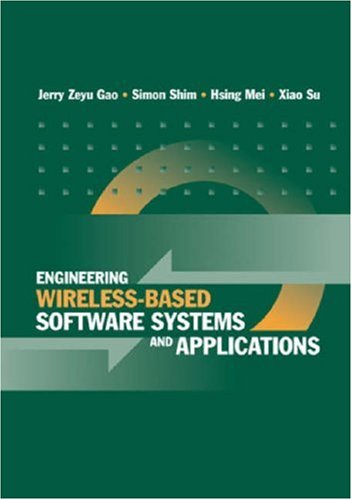Mobile Commerce and Wireless Computing Systems
暫譯: 行動商務與無線計算系統
Geoffrey Elliott, Nigel Phillips
- 出版商: Addison Wesley
- 出版日期: 2003-08-15
- 售價: $980
- 貴賓價: 9.8 折 $960
- 語言: 英文
- 頁數: 552
- 裝訂: Paperback
- ISBN: 0201752409
- ISBN-13: 9780201752403
無法訂購
買這商品的人也買了...
-
 計算機組織與設計--軟硬體界面第二版 (Computer Organization & Design, 2/e)
計算機組織與設計--軟硬體界面第二版 (Computer Organization & Design, 2/e)$680$537 -
 C++ Primer, 3/e 中文版
C++ Primer, 3/e 中文版$980$774 -
 Operating System Concepts, 6/e (Windows XP Update)
Operating System Concepts, 6/e (Windows XP Update)$1,050$1,029 -
 ASP.NET 程式設計徹底研究
ASP.NET 程式設計徹底研究$590$466 -
 鳥哥的 Linux 私房菜-伺服器架設篇
鳥哥的 Linux 私房菜-伺服器架設篇$750$638 -
 Tomcat 技術手冊 (Tomcat: The Definitive Guide)
Tomcat 技術手冊 (Tomcat: The Definitive Guide)$720$569 -
 鳥哥的 Linux 私房菜─基礎學習篇增訂版
鳥哥的 Linux 私房菜─基礎學習篇增訂版$560$476 -
 Dreamweaver MX 2004 魔法書中文版
Dreamweaver MX 2004 魔法書中文版$490$417 -
 Linux 驅動程式 (Linux Device Drivers, 2/e)
Linux 驅動程式 (Linux Device Drivers, 2/e)$880$695 -
 Linux 與 Windows 共舞─異質平台整合方案
Linux 與 Windows 共舞─異質平台整合方案$650$553 -
 SCJP‧SCJD 專業認證指南 (Sun Certified Programmer & Developer for Java 2 #310-305 與310-027)
SCJP‧SCJD 專業認證指南 (Sun Certified Programmer & Developer for Java 2 #310-305 與310-027)$850$723 -
 802.11 完全剖析無線網路技術
802.11 完全剖析無線網路技術$620$484 -
 專案管理實務入門-引導專案成功的52條準則
專案管理實務入門-引導專案成功的52條準則$280$218 -
 人月神話:軟體專案管理之道 (20 週年紀念版)(The Mythical Man-Month: Essays on Software Engineering, Anniversary Edition, 2/e)
人月神話:軟體專案管理之道 (20 週年紀念版)(The Mythical Man-Month: Essays on Software Engineering, Anniversary Edition, 2/e)$480$379 -
 JSP 2.0 技術手冊
JSP 2.0 技術手冊$750$593 -
 Postfix 技術手冊 (Postfix: The Definitive Guide)
Postfix 技術手冊 (Postfix: The Definitive Guide)$720$569 -
 建構嵌入式 Linux 系統
建構嵌入式 Linux 系統$780$616 -
 CCNA 認證教戰手冊 Exam 640-801 (CCNA Cisco Certified Network Associate Study Guide, 4/e)
CCNA 認證教戰手冊 Exam 640-801 (CCNA Cisco Certified Network Associate Study Guide, 4/e)$780$663 -
 JSP 與 Servlet 500 個應用範例技巧大全集
JSP 與 Servlet 500 個應用範例技巧大全集$590$460 -
 Windows CE 嵌入式系統理論與實務
Windows CE 嵌入式系統理論與實務$680$537 -
 最新 JavaScript 完整語法參考辭典 第三版
最新 JavaScript 完整語法參考辭典 第三版$490$382 -
 C++ 程式設計藝術 (C++ How to Program, 4/e)
C++ 程式設計藝術 (C++ How to Program, 4/e)$820$738 -
 Eclipse 整合開發工具 (Eclipse)
Eclipse 整合開發工具 (Eclipse)$540$427 -
 RFID 技術與應用
RFID 技術與應用$480$408 -
 Head First Design Patterns (Paperback)
Head First Design Patterns (Paperback)$2,350$2,233
商品描述
Mobile Commerce and Wireless Computing Systems looks at the technical domain of m-commerce, which consists of the buying and selling of goods and services through wireless handheld devices. The book discusses the what, why, and how of m-commerce with a focus on mobile networking and mobile commerce applications. The book starts by covering the theory behind mobile commerce, then puts the theory into practice, covering technologies, approaches, applications, and design issues. It also examines strategic planning options needed in a mobile commerce world.
Table of Contents
1. Defining Mobile Commerce and Electronic Business.
2. Static and Mobile Networking.
3. Telecommunications.
4. Business Applications.
5. Mobile Systems Design.
6. Systems Integration.
7. Social and Economic Implications.
8. Global M-Commerce Futures.
Appendices.
商品描述(中文翻譯)
《行動商務與無線計算系統》探討了行動商務(m-commerce)的技術領域,該領域包括通過無線手持設備進行商品和服務的買賣。本書討論了行動商務的定義、原因和方法,重點關注行動網絡和行動商務應用。書中首先介紹了行動商務背後的理論,然後將理論付諸實踐,涵蓋技術、方法、應用和設計問題。它還檢視了在行動商務世界中所需的戰略規劃選項。
目錄
1. 定義行動商務與電子商務。
- 定義。
- 參考模型。
- “E”和“M”前綴。
- 行動商務與電子商務的比較。
2. 靜態與行動網絡。
- 網絡與行動操作系統。
- 網絡計算機系統架構與拓撲。
- 分散式與行動系統環境。
- 互聯網擴展與互聯網中心應用。
- 軟體開發與互聯網。
- 行動與互聯網協議。
- 無線應用協議(WAP)。
- 動態程式設計(XML, WML)。
- 網絡無線系統架構。
- 傳輸標準與協議。
- 行動商務技術標準。
3. 電信。
- 網絡計算機系統架構的性能與限制。
- 分散式計算機系統的設計、建設與成本限制。
- 行動技術在分散式計算環境中的影響。
- 行動商務拓撲與無線架構。
- 固定與無線電信架構。
- 網絡與分散式計算的驅動力。
- 傳輸參數與數位應用環境。
- 數據同步技術。
- 存取安全與第三代行動網絡。
- 公共金鑰基礎設施(PKI)與金鑰管理架構。
- 輕客戶端技術與舊系統。
- 代理技術與行動商務。
- 維護行動商務網絡。
4. 商業應用。
- 基於互聯網的商業環境。
- 基於無線的網絡環境。
- 行動企業商業應用(MEBAs)。
- 控制論與增強商業領域。
- 電子商務架構與方法。
- 行動商務架構與方法。
- 技術發展與組織變革。
- 推送與拉取工作流程系統。
- 長期交易。
- 整合行動商務環境。
- 資訊與知識入口。
- 使用者認知地圖與客戶分析。
- 智能代理與智能搜尋。
5. 行動系統設計。
- 能力與應用。
- 行動商務系統層級。
- 激勵場景。
- 客戶-零售商商業模型。
- 供應商-組織商業模型。
- 組織-組織商業模型。
- 客戶啟用技術。
- 整合行動商務系統。
- 行動商務與電子商務的過程審計。
- 移動性與需求。
- 移動性與供應。
6. 系統整合。
- 整體系統整合。
- 行動互聯網計算。
- 電子商務與互聯網。
- 智能卡與電子支付系統。
- 行動商務中的數位簽名與電子身份。
- 行動設備與應用版本管理。
- 互聯網啟用的商業環境。
- 組織運營環境。
- 全球互聯網商務。
- 互聯網使用者評估。
- WAP使用者評估。
- 行動商務的產業與商業案例。
- 從行動商務系統中獲取收入。
7. 社會與經濟影響。
- 行動商務安全與法律。
- 行動商務的社會與經濟基礎設施。
- 行動商務的服務與定價策略。
- 行動互聯網接入的成本與收費。
- 行動商務安全中的加密問題。
- 隱私與自由。
- 知識管理與行動商務。
- 嵌入式行動技術(例如“藍牙”)。
- 政府與教育應用。
- 全球戰略行動商務思維與實踐。
8. 全球行動商務的未來。
- 歷史趨勢分析。
- “藍牙”技術的應用。
- 動態主機配置協議(DHCP)。
- 行動商務規劃週期。
- 行動商務商業整合策略。
- 行動商務機會分析。
- 現有與未來的商業行動商務系統。
- 行動商務系統的推出與總擁有成本。
- 研究與開發。
- 行動商務的方向。
附錄。
- 多選測驗。
- 團體與個人導向學習。










